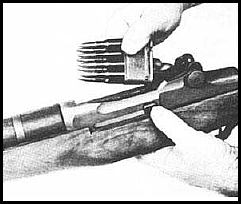M1 Garand Bolt-Action Semiautomatic Rifle. American Soldier's Advantage in World War II, and Still Beloved by Veterans.

As the world's first semi-automatic rifle issued to combat troops, the M1 Garand has taken its rightful place in history, and in the hearts and minds of those who used it. Designed by John Garand at the Army's famed Springfield Armory, the now legendary rifle was the result of a long and drawn-out series of disappointing tests and failures. Beginning in 1924, when test after test was deemed "inconclusive" with Garand's design being pitted against other rifles, caliber changes, and at one point, being pulled back due to a cracked bolt, it seemed doomed to fail. But the persistence of the rifle's designer led to an eventual decision, in part because of improvements made to the original design, and also due to the large supply of .30 caliber M1 ball ammunition that was in stock. In fact, the approval of the M1 Garand was a result of an order given by then Army Chief of Staff General Douglas MacArthur--who went on to greater fame--to disapprove any further caliber changes. The Secretary of War concurred with this assessment, and the M1 began its climb to glory--but not without a few more missteps along the way.
American Cavalry and Infantry uncovered
otherproblems during
further testing in the field, but these were soon corrected The start
of World War II in Europe put the Garand rifle on the fast track. The
contract to produce the M1 Garand went to Winchester, and when American
troops went to war, the M1 Garand went with them. By the time World War
II ended, many American allies also adopted the M1. Production of M1s
expanded still more during the Korean War. International Harvester,
Harrington & Richardson, and even the Italian arms producer,
Beretta were soon cranking out M1s, producing well over five
million M1 Garands. Commercial models intended for civilian sportsmen
soon followed
The M1 Garand's semi-automatic gas-powered rotating
bolt action allowed for much faster firing and gave American forces an
advantage over German and Japanese forces who had still been using the
older single-shot bolt-action rifles. Axis powers were quick to take
note, and there followed a remarkably fast development of fully
automatic weapons by both the Americans and the Axis powers. The
Winchester .30-06 rounds used by the Garand not only had a greater rate
of fire, but produced more lethal results than the Axis
weapons. The M1's portability also
gave American troops the ability to surround and
overtake the stationary machine gun positions the Germans and Japanese
had employed with such deadly effect throughout the war, and that
characteristic doubtless saved many American lives.

Perhaps the most famous characteristic of the M1 Garand was its forward-facing eight-round clip which automatically ejected when empty with a loud metallic clang, like the ringing of a bell. This was a source of both alarm and humor to American troops, since it allowed the Germans and Japanese to know when a GI was out of ammo and capitalize on it. But the ever-resourceful American troops quickly turned this into an advantage by using the "clang" as a trap to lure their opponents into the open. There were tests designed to fix this problem, but the M1 remained unchanged, since by that time, the focus had shifted to development of the FULLY automatic rifles gradually overtaking the semi-automatic M1 as standard issue firearms. American Paratroopers were already successfully deploying the military version of the Thompson submachine gun, and the Germans were producing the MP40 "Schmeisser" for their SS and Luftwaffe counterparts. Even so, having proven itself in combat, the M1 continued to see action in the 1950's Korean War, and to a lesser extent, in Vietnam.
The M1 Garand
Semi-Automatic Rifle
unquestionably helped the United States and its allies to win World War
II, and gain a huge following. Beloved by the likes of General Patton
and countless sportsmen and collectors of militaria, it is
still used by the United States military for ceremonial drill teams and
parades. Like the famed and reliable Colt M1911A1 .45 automatic
pistol--another favorite of American military veterans-- it is a true
patriot's firearm, and remains so to this day. An M1 Garand rifle in
usable condition commands a high price on today's collectors' market.
Firearm Type:
Bolt-Action, Semi-Automatic
Nation Of Manufacture: USA
Military Service Dates : 1936-1970 (Still
used in limited capacity)
Variations: M1, M1C, M1D
Ammunition: 30-06, 7.62mm
Wars: World War II, Korean War, Vietnam
Recent Prices at Auction for Originals: US
$500-$3,000
Interested in an authentic replica M1 Garand rifle?